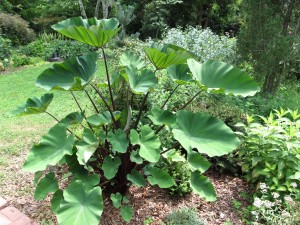Colocasia (Colocasia esculenta), aka taro, ape plant, and elephant ear, among other names, is marginally hardy in the Southern Appalachian region (USDA hardiness zones 6 and 7). The 2011 colocasia introduction ‘Bikini-tini’ has garnered high praise from neighbors and friends visiting my garden in the summer.
Bikini-tini is a strong stemmed thick-leaved plant that grows 4 to 5 feet in height. Its bluish-gray leaves cup upward, supported by dark purple petioles and prominent veins beneath. Its cupped leaves capture and pour out rainwater, creating motion in the garden.
Elephant ears are easy to grow. Your garden or container soil should be well drained and compost rich. Soil pH should range between 5.6 and 7.0. Site in direct sunlight, and keep the soil moderately moist. Elephant ears are heavy feeders and thrive on a steady diet of water plus fertilizer. Use a water soluble product such as Miracle-Gro®, Jack’s Classic®, or Daniels® every 2-3 weeks from mid-May (planting time) to late August at the one-half strength rate. An alternative is to feed once with an organic slow release fertilizer in early spring.
Disease and pest problems are rare when plant(s) are properly sited and cared for. Potential crown or stem rot problems are best avoided by growing in a well drained soil (media) and by not overwatering.
Bikini-tini is rated winter hardy to USDA zone 6 with some protection. Protect the crown over the winter with 2-3 inches of a loose leafy mulch such as straw or oak leaves.


 Posted in
Posted in 
